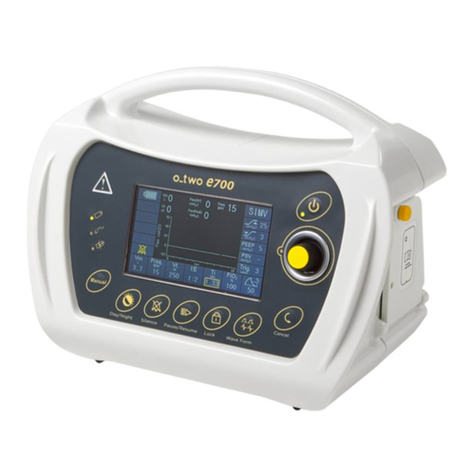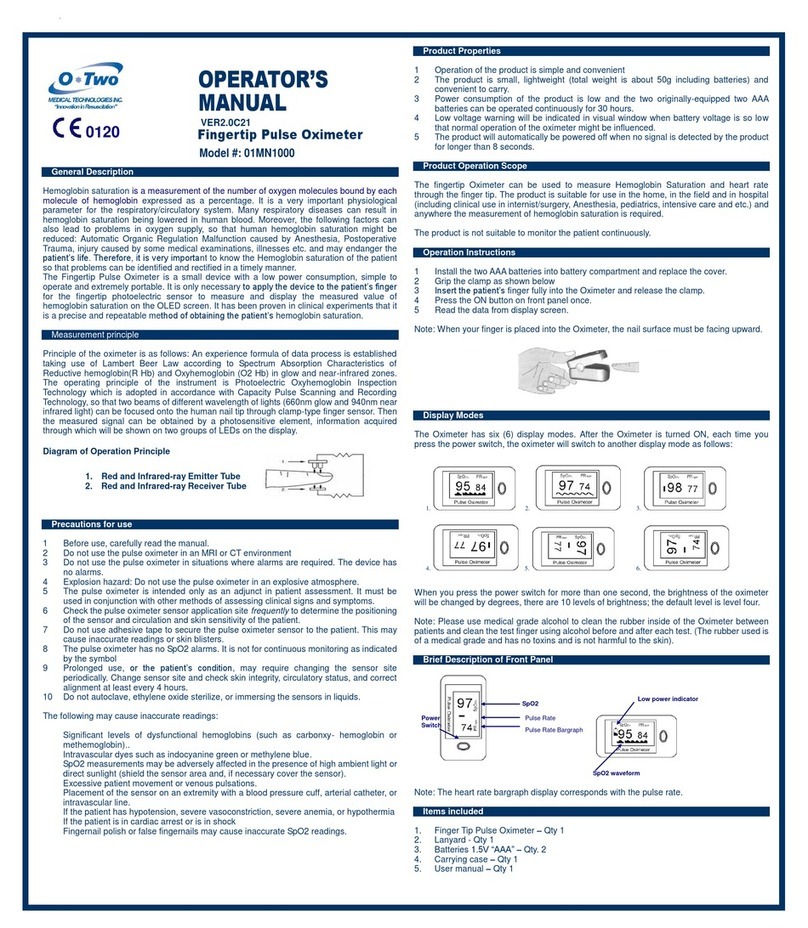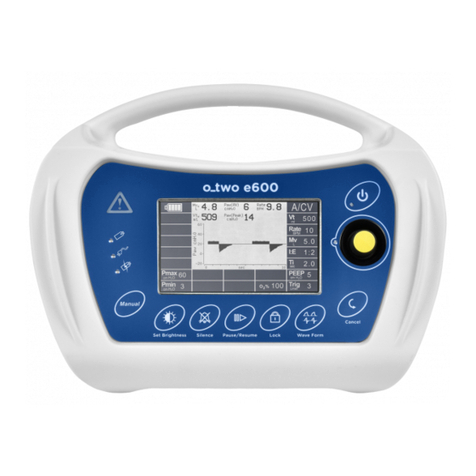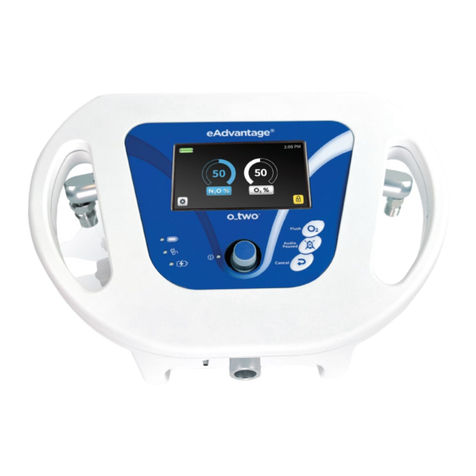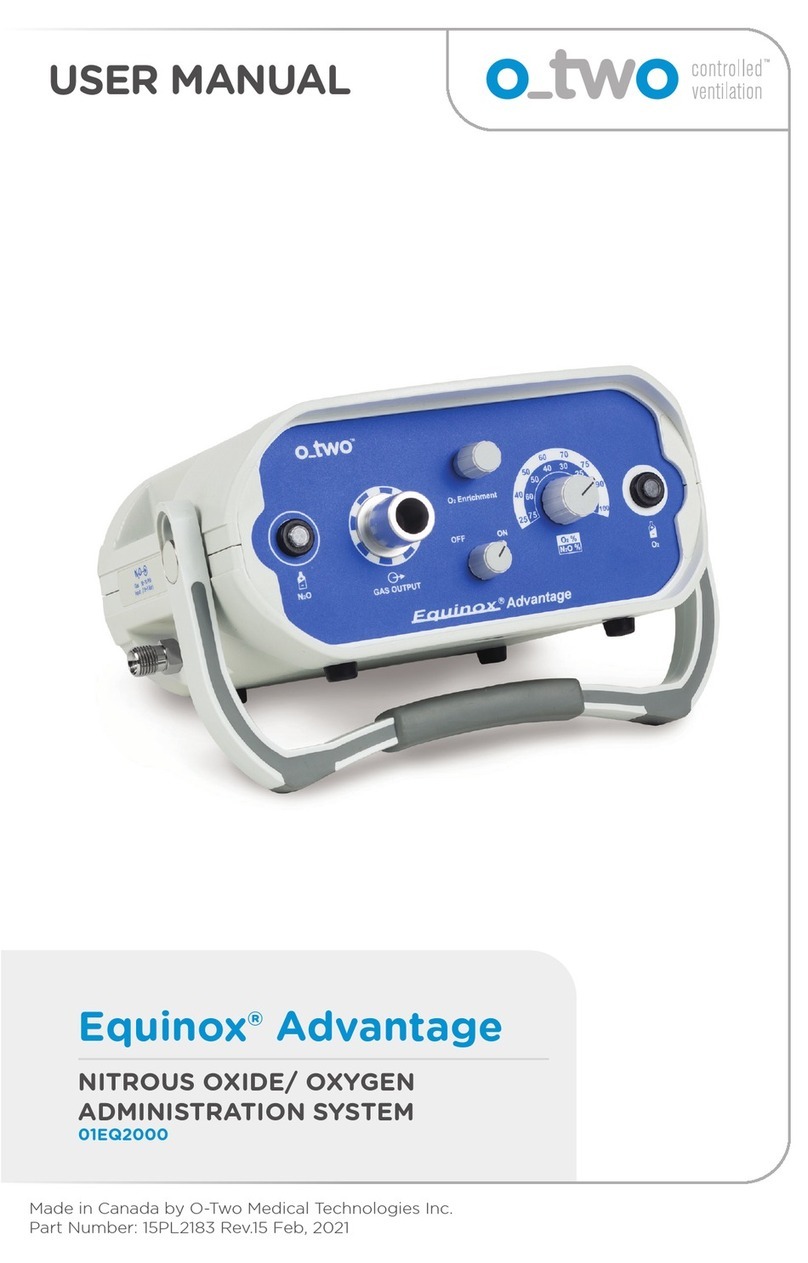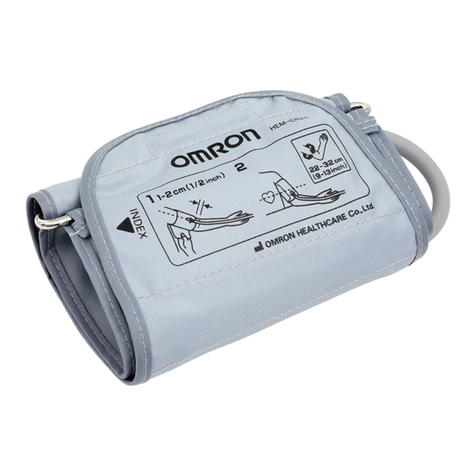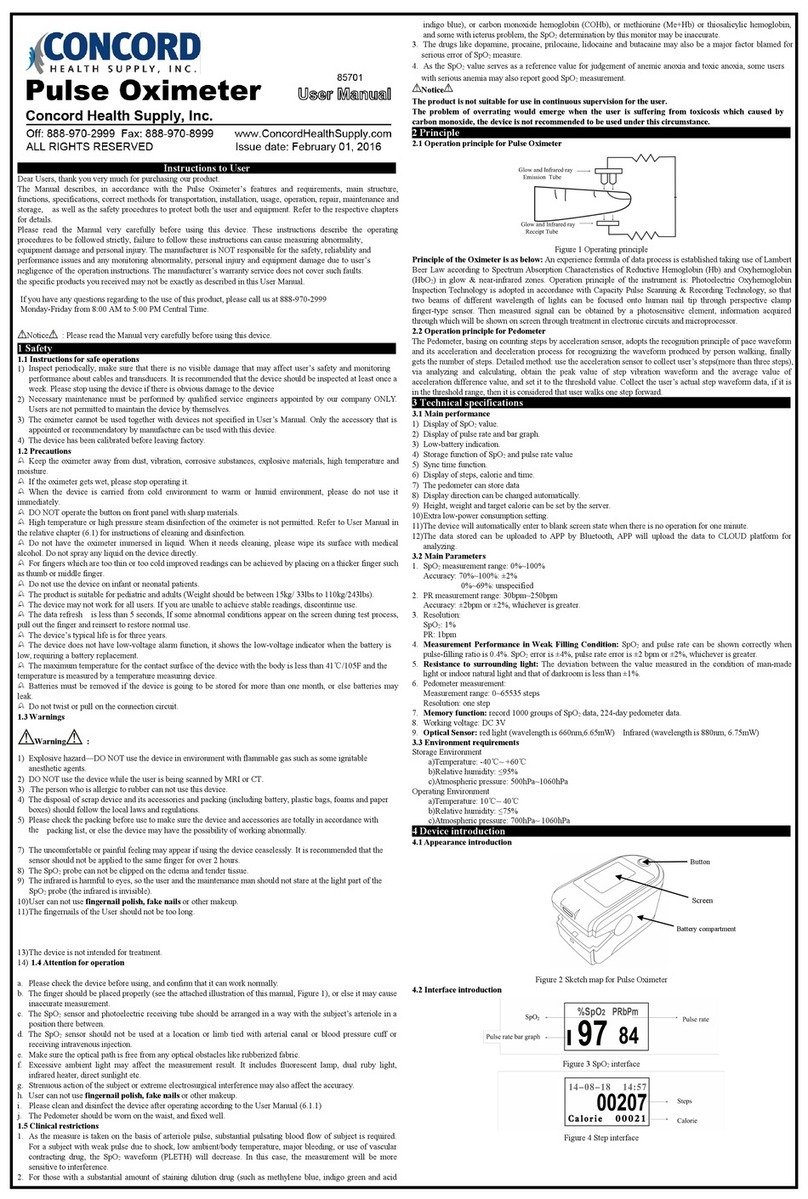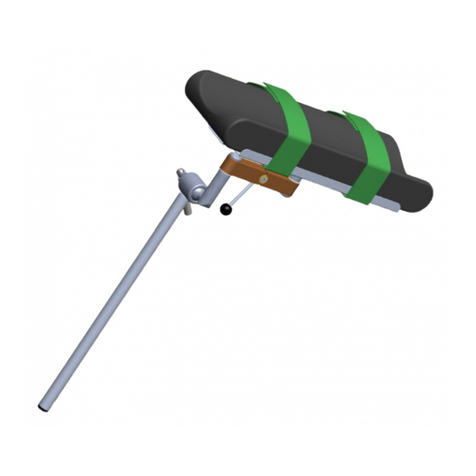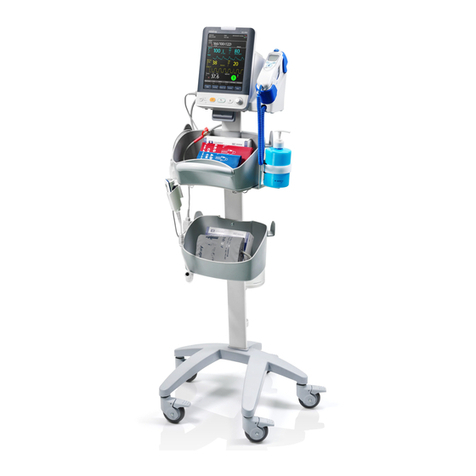O-Two CAREvent CA-G05 User manual

5
6
Along with the contents of the shipping carton you will require the
following items to enable you to undertake the pre-use functional
check:
[1] Full breathing air or medical grade oxygen cylinder.
[2] Air or oxygen regulator with a 50 PSI outlet and the correct DISS or
quick connector for the gas being used. The regulator must be
able to deliver an output flowrate of >120 L/min at no less than
45 PSI (3.1 Bar).
[3] Calibrated Test Lung.
Having connected the supply hose to the regulator, turn on the gas
supply. Using a mild soap solution, spray the input connection to the
resuscitator to check for leaks. If any leak is present, tighten the
connection “by hand” (Do not use a wrench) and re-test.
Once no leaks are found, connect the test lung to the 15/22mm patient
connector on the resuscitator. If the leak cannot be stopped, check and
replace the sealing “O” ring on the hose connection to the resuscitator. If
the leak persists, replace the hose.
The following features can be individually tested during the Pre-use
Functional Check:
[1] Peak Airway Pressure and Audible Alarm.
[2] Ventilation Frequency and Tidal Volume.
[3] Manual Ventilation.
[4] Demand Valve Function and Automatic Circuit Shut Off.
[5] Bleed Flow.
The supply hose provided is attached to the oxygen inlet on the rear of
the resuscitator and is tightened “finger tight” (fig 1).
The use of excessive force in tightening the supply hose
may damage the seal and /or thread.
The facemask is attached to the patient connection port by simply
pushing the mask onto the 22mm taper.
Manual Button
Attach supply
hose here
The ®has a Manually Actuated,
Automatic Ventilation Override Button (Manual Button) with a 20 second delay
to automatic cycling re-start to assist in the timing of ventilations in conjunction
with external cardiac compressions.
By using the Manual Button”, the operation of the ventilator can be easily
timed with the chest compressions so as to avoid the potential problem of
the aspiration of stomach contents due to gastric distension which may
occur if overlap of chest compression and inflation occurs. (It has been
shown in some studies that, in patients that are intubated, this overlap of
compression and inflation may increase cardiac output without the danger
of gastric distension.) The flowrate provided is equivalent to the preset
automatic flowrate.

7
4
1. If no respiratory effort is observed, position yourself above the
patient’s head. Turn on the gas supply.
2. Allow the device to cycle once and then apply the face mask over
the patients mouth and nose.The thumb and index fingers are used
to hold the mask to the face while the remaining three fingers of
each hand are placed along the angle of the jaw. A tilt action is used
to hyperextend the neck and move the jaw forward. This helps
displace the tongue away from the back of the throat and
maintains an open airway.
3. If manual Ventilation is to be used depress the manual button and
observe the rise of the patient’s chest. Release the button when
chest rise is adequate.
4. If the patient’s chest does not rise or gas escapes around the mask
or the pressure relief system (c) operates (fig 3), reposition the
patients head and adjust your hand position to obtain an effective
mask seal and an open airway.
5. Monitor the patient’s skin, nailbed and lip colour
6. If mask indicates signs of vomitus, remove immediately and clear
the airway. Ensure the mask and valve are free from obstruction.
Restart ventilation immediately after clearing airway. (See also 2.4).
7. Continue ventilation at an appropriate rate until relieved or until
spontaneous breathing returns.
1. If you are commencing automatic ventilation immediately, follow
steps 1 -2 and 4 - 7 above.
2. Closely observe the patient’s chest movements. If there is any leak
from around the mask or any obstruction in the patients airway
(blow off valve will operate) reposition patients head and adjust
mask and hand position to ensure a good airway and mask to face
seal.
If the patient is intubated (or if the patient is to be intubated
following mask ventilation), remove the face mask from the
22mm connector and attach the device onto the 15mm En-
dotracheal tube connector.
®is designed to provide
emergency ventilatory support to patients suffering from respiratory and/or
cardiac arrest.
is intended for use by
suitably trained and qualified personnel. The following precautions should
always be observed:
1. WHEN NOT IN USE, ALWAYS TURN OFF THE CYLINDER.
2. NEVER ALLOW OIL OR GREASE TO COME INTO CONTACT
WITH ANY PART OF THE CYLINDER, REGULATOR OR
RESUSCITATOR.
3. DO NOT DISASSEMBLE ANY PART OF THE RESUSCITATOR
EXCEPT WHERE DESCRIBED IN THIS MANUAL, AS ANY
UNAUTHORIZE D DISASSEMBLY WILL INVALIDATE THE
WARRANTY.
4. AFTER USE, ALWAYS ENSURE THAT ALL COMPONENTS
ARE CLEANED IN ACCORDANCE WITH THE INSTRUCTIONS
PROVIDED IN THIS MANUAL.
5. ENSURE THAT ALL COMPONENTS ARE REASSEMBLED
CORRECTLY AND THAT ALL ITEMS ARE REPLACED IN THE
CARRYING CASE.
6. AFTER USE, ALWAYS ENSURE THAT A FULL AIR OR OXYGEN
CYLINDER IS ATTACHED BEFORE RETURNING THE UNIT TO ITS
NORMAL STORAGE POSITION.
7. ENSURE THAT A NEW SEALING WASHER IS USED EVERY TIME
YOU ATTACH THE REGULATOR TO THE CYLINDER.
8. IT IS RECOMMENDED THAT AN ALTERNATIVE MEANS OF
VENTILATING THE PATIENT BE AVAILABLE IN CASE OF GAS
SUPPLY FAILURE.
.

8
3
TIDAL VOLUME: 0.5 litres
BREATHS PER MINUTE: 10
I:E RATIO: 1 : 2
AUTOMATIC FLOW RATE: 15.0 L/Min
MANUAL FLOW RATE: 15.0 L/Min
DELAY TO AUTOMATIC CYCLING RE-START
AFTER MANUAL BUTTON DEPRESSION: 20 SECONDS
POSITIVE PRESSURE BLEED FLOW: 2 L/Min
AUTO SHUTOFF 5 to 8 s
DEMAND BREATHING FLOWRATE: 0 –120L/Min
INSPIRATORY RESISTANCE @ 60 L/Min: 0 to - 6 cmH20
INPUT PRESSURE: 45 - 87 PSI
3.1 - 6 Bar
MAXIMUM AIRWAY PRESSURE: 60 cmH20
58.8 mBar
OPERATING TEMPERATURE: -18oC to + 50oC
0oF to +122oF
STORAGE TEMPERATURE: - 40oC to + 60oC
- 40oF to +140oF
INPUT CONNECTION: 9/16” DISS
PATIENT CONNECTION: 15 / 22 mm
PATIENT VALVE DEAD SPACE: 8 ml
WEIGHT: 16 OZ / 0.45 Kg
SIZE: 140 x 63 x 73 MM
5.5 x 2.5 x 2.9IN.
CYLINDER DURATION:
@ 10 BPM / 0.5 Litres VT 82 minutes
(Based on an Aluminum “D” size cylinder containing 415 Litres of air or
oxygen.)
Should the patient vomit into the mask during resuscitation the
following steps should be followed to clear the foreign material:
1. Remove the mask from the patient’s face and clear any foreign
material from the patients airway. Depress the manual button
or allow the resuscitator to cycle automatically for a few breaths
to clear the mask and valve of foreign material.
2. If depressing the manual button repeatedly or automatically
cycling the resuscitator does not clear the foreign material from the
patient valve,turn the selector to the OFF position, remove the
facemask and unscrew patient valve swivel housing (e) from the
resuscitator body being careful to ensure that the diaphragm is
retained (Fig.3).
3. Shake out any foreign material from the resuscitator, diaphragm,
face mask and patient valve swivel housing.
4. Reassemble the facemask, patient valve and diaphragm and
attach to the resuscitator.

9
2
Should the patient commence spotaneous breathing at a flowrate of
greater than 30 lpm for more than 1 second the ®will
sense the patient’s inspiratory effort and will stop cycling automatically
allowing the patient to “De- mand Breathe”at their own rate and volume
on 100% oxygen (if connected to an oxygen supply). If they cease
spontaneous breathing the ventilator will recommense automatic
cycling after a delay of 5 - 8 seconds (depending on the depth of the
patients previous respiration) without intervention by the rescuer.
®
The ®is a pneumatically
powered, time/volume cycled ventilatory resuscitator with the added
feature of a Manually Actuated, Automatic Ventilation Override Button
(Manual Button) to allow the operator to control the ventilations manually at
a rate and volume they desire. The ventilator allows the breathing patient to
“Demand Breathe”through the device. Their inspiratory effort causes the
automatic cycling to cease. Should they stop breathing the ventilator will
automatically restart cycling in the setting selected.
A 2 litre per minute constant “BLEED FLOW”is provided to ensure a positive
remains in the mask throughout the ventilation cycle to decrease the risk
of entraining potentially toxic atmospheric air into the mask.
The “pneumatic logic circuit”can be run on either approved, compressed,
breathing air or medical oxygen. The unit is self-contained and only
requires its attachment to a regulated oxygen or air supply (as specified) for
immediate use.
CA-G05 Handheld Resuscitator is ®
To ensure proper operation of the resuscitator regular inspection and
checking of the resuscitator and accessories for correct function should
be undertaken by a responsible member of staff on a routine basis. This
check is to ensure that all of the accessories and resuscitator
components are present, the air or oxygen cylinder is full and that the
resuscitator is in working order.
Regulator working pressure, suction (if equipped), and ventilator limiting
pressures should be checked at least every six months, and more
frequently in high use applications. Units with test pressures outside of
the ranges listed in the product specifications should not be used. The
product is not designed for field disassembly or service outside that
indicated in this manual. Any malfunctioning units should be returned to
the manufacturer or an Authorised Dealer. Unauthorised repairs will nullify
the product warranty.
. Can be operated on either breathing air or medical grade oxygen.
. Meets the American Heart Association and European Resuscitation
Council Guidelines 2005 (G05) recommendations for CPR.
. Provides a physiologically normal adult respiratory rate and volume.
. Has an Audible Airway Pressure Limiting System.
. Is lightweight and extremely durable.
. Is designed for resuscitation in potentially toxic atmospheres.
. Has a Manually Actuated, Automatic Ventilation Override Button
(Manual Button) with a 20 second delay to re-start of automatic
cycling to allow the provision of 30 chest compressions.
. Complies with the requirements of the ERC and AHA Guidelines
2005 (G05) for the provision of a 30:2 compression:ventilation ratio.
. Has a preset, automatic setting compatible with a range of adult
patients with a tidal volume and frequency of ventilation in line with
established guidelines.
. Provides “Demand Breathing” with automatic cycling shut off and
restart.
. Has a 2 L/min Bleed Flow to reduce the risk of air entrainment due to
mask leakage

1
10
The provides trained
individuals with a safe and effective means of providing artificial ventilation
during respiratory and/or cardiac arrest.
Theis lightweight, portable,
and extremely durable. Designed for the demands of the emergency
medical and rescue environment where toxic gas may be present, they
can be operated anywhere medical oxygen or breathing air supply is
present.
An Automatic and Manually Triggered Resuscitator is
considered a critical device, and its components considered critical
components. Only those individuals trained in Cardio- Pulmonary
Resuscitation and the operation of oxygen-powered ventilators should use this
equipment. Thoroughly review this instruction manual before use.
Routine cleaning of the equipment should be undertaken to maintain the
equipment in a clean condition.
Reusable patient valve swivel housing and diaphram can be cleaned using a
mild soap solution and disinfected using a legally marketed commercially
available disinfectant, suitable for the application. Single use patient
valves and masks should be discarded after each patient use and replaced
with a new unit.
All other components should be wiped clean with a mild soap solution.
Under no circumstances should the complete unit be allowed to be soaked
or immersed in cleaning solutions.
The CAREvent CA is designed to deliver medical oxygen and medical air to
adult patients to provide short term ventilator support in pulmonary
resuscitation in emergency medical and rescue environment where toxic
gas may be present. The ventilator is suitable for use in:
• Pulmonary resuscitation during respiratory and/or cardiac arrest.
• Short term ventilatory support in the confined space rescue in IDLH
(Immedi- ately Dangerous to Life and Health) environment, pre-hospital, Intra-
hospital, inter- hospital and air ambulance transport of non-breathing
patients.
[a] Resuscitator
Body
[b] Gas Supply
Inlet
[c]PressureRelief
System
[d] Manual Button
Federal law restricts this device to sale by or on the order of a
physician.
This equipment is manufactured from the finest quality materials. Each
individual part is subject to strict quality control tests to ensure exceptionally
high standards. The manufacturer warrants to the purchaser of the
that its component parts are free
from defects in material and workmanship for a period of two years from the
date of purchase. The manufacturer will replace and/or repair all parts of the
resuscitator at its option for two years from the date of purchase at no cost to the
purchaser, upon the notification of the defects, in writing by the purchaser. All
shipping costs shall be borne by the purchaser. The manufacturer shall be
liable under this warranty only if the resuscitator and its parts have been
used and serviced in the normal manner described in the instruction manual.
There are no other expressed or implied warranties. This warranty gives no
specific legal rights. You may also have other rights that may vary according to
local regulations.
[e]Patient Valve
Swivel Housing
[f] Facemask

11
1. Operate CAREvent® CA-G05 Handheld Resuscitator toblow out any
contaminant from thepatientvalve.
2. Ensure CAREvent® CA-G05 Handheld Resuscitator is disconnected
from the gas supply source.
3. Removethepatientvalveswivelhousing(a)fromthebodyoftheresuscitator
(c), being careful to ensure that the diaphram (b) is retained (fig 3).
4. Remove the facemask from the resuscitator (after removing the mask
retaining insert (if supplied) using the extraction tool).
5. Shake out any foreign material.
6. Washallcomponentsthoroughlyina mild soapsolutionand disinfectas
required.
7. Theresuscitatorcanbewipedoverwithasoftclothandmildsoapsolution.
8. Dryallcomponentsthoroughly.
9. Reassemble unit, connect to an air or oxygen supply tocheck operation
priortopackagingforemergencyuse.
.
®
17MP9039
Reusable patient valve swivel housing
17MP1528
Reusable Patient Valve Diaphragm
01FG6500
Mask Retaining Insert
01FG6501
Mask Insert Extraction Tool
01FG6502
Head Harness System
17MP7010
Single Use PEEP Valve
01FV4314
Conversion Hose O2 - Air
1
1.1 Introduction 1
1.2 WarrantyInformation 1
1.3 The CAREvent® CA-G05 Features 2
1.4 Performance Specifications 3
1.5 Safety Precautions 4
2
2.1 Set Up 5
2.2 Testing of the Individual Features
oftheVentilator. 5
3
3.1 Connecting the Supply Hose and
Patient Circuit 6
3.2 ManualVentilationandCardiac
Compressions 6
3.3 AutomaticVentilation 7
3.4 Action to beTaken if Patient
Vomits During Resuscitation 8
3.5 Demand Breathing and Automatic
Circuit Shut Off 9
4
4.1 RoutineMaintenance 9
4.2 Cleaning andSterilization 10
5 11

®
Other O-Two Medical Equipment manuals
Popular Medical Equipment manuals by other brands

Chattanooga
Chattanooga Intelect Mobile 2 Ultrasound quick start guide

Dräger
Dräger Julian Instructions for use
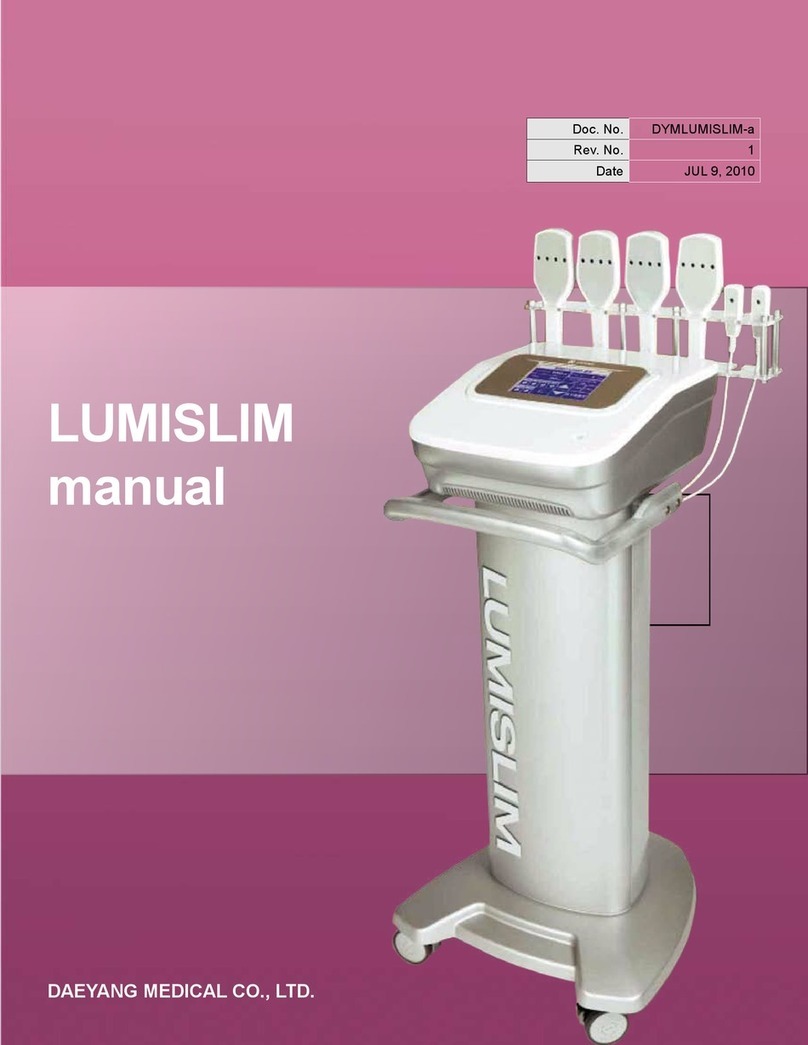
DAEYANG MEDICAL
DAEYANG MEDICAL LUMISLIM manual

Dräger Medical
Dräger Medical Fabius GS Rail manual
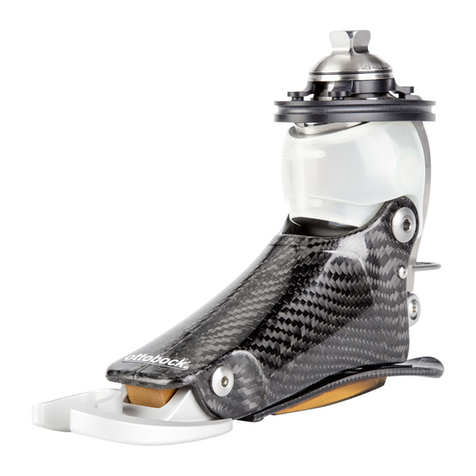
Otto Bock
Otto Bock 1B1-2 Meridium Instructions for use

ChoiceMMed America Co
ChoiceMMed America Co MD300C1DS user manual
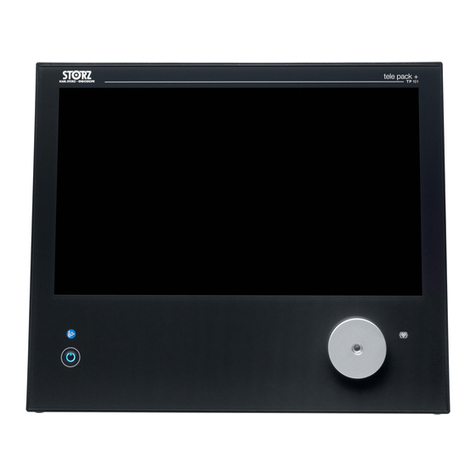
Karl Storz
Karl Storz TELE PACK + Instructions for use
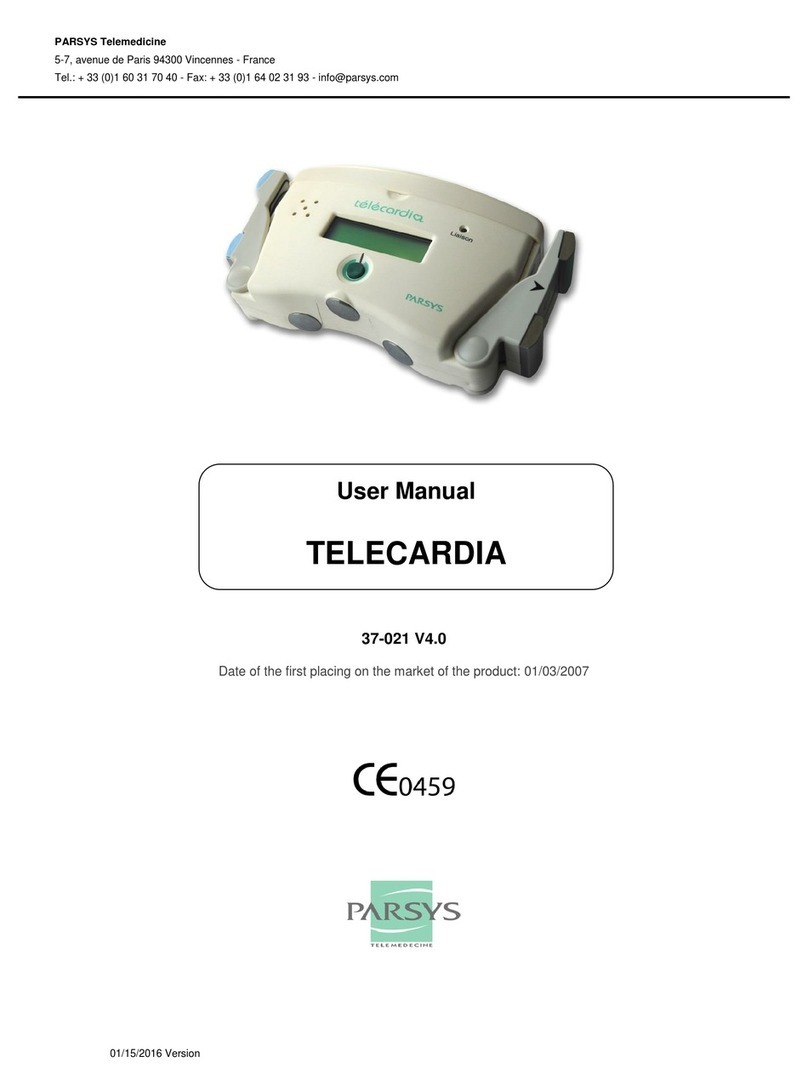
PARSYS
PARSYS TELECARDIA user manual
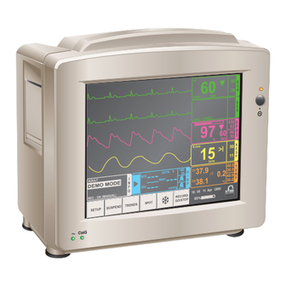
Huntleigh
Huntleigh Smartsigns Compact SC750 Instructions for use
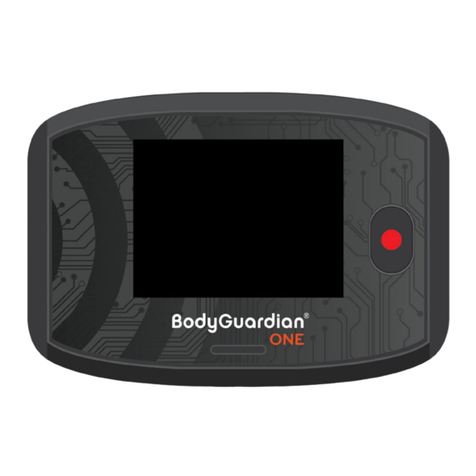
Boston Scientific
Boston Scientific Preventice Solutions BodyGuardian ONE Patient Instruction Manual
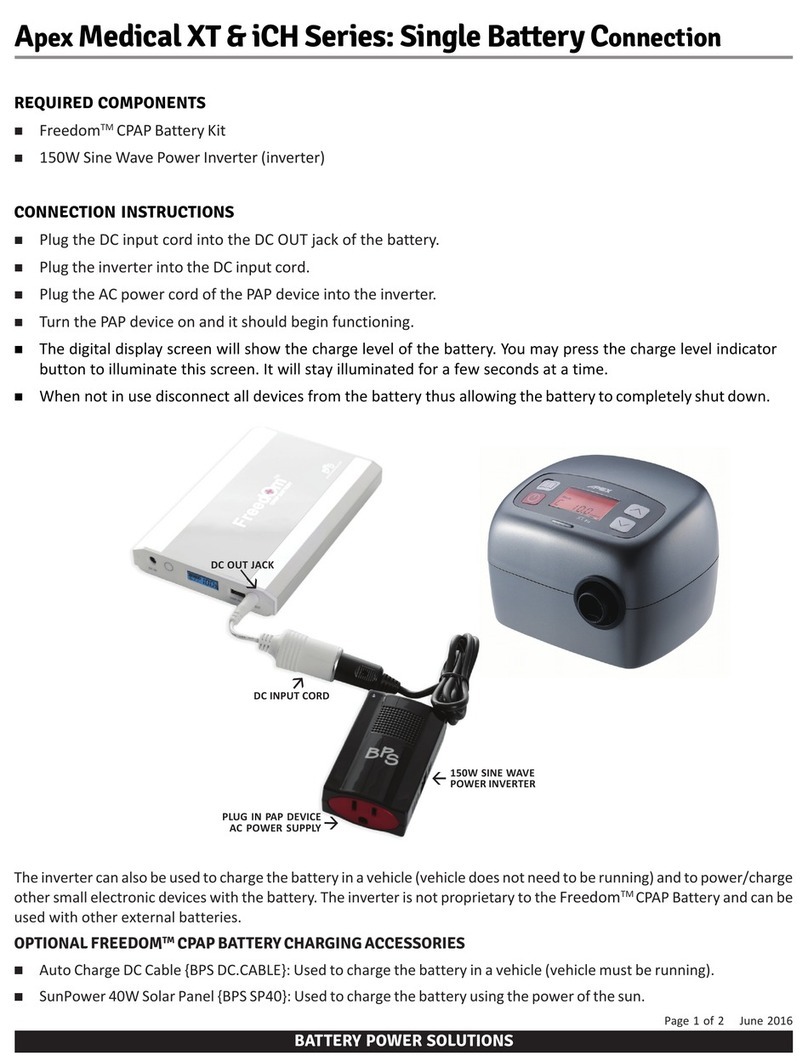
Apex Medical
Apex Medical XT Series manual
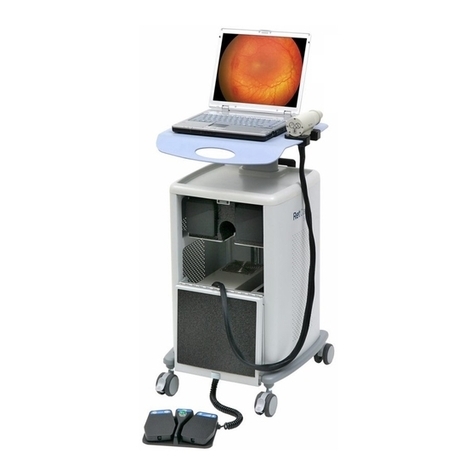
Clarity
Clarity RetCam Shuttle User manual and service instructions

